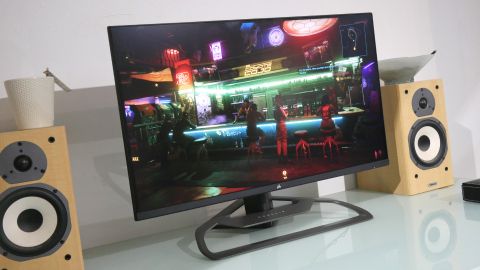TechRadar Verdict
The new Corsair Xeneon 32QHD165 gets nearly everything right for an all-round gaming panel. Decent resolution, high refresh, fast response, great image quality, good build, strong feature set, the works. It’s just a pity it’s quite so pricey.
Pros
- +
Fab all-round image quality
- +
Plenty quick enough
- +
Good build quality and feature set
Cons
- -
Painfully pricey
- -
Not a true HDR panel
Why you can trust TechRadar
Two-minute review
If you’re pondering the question of what makes for the best all-round gaming monitor, the new Corsair Xeneon 32QHD165 might just be the answer. On paper, at least.
With a 32-inch 1440p panel running at up to 165Hz refresh, it arguably nails exactly the right balance between performance and graphical detail. Sure, there are gaming monitors with more pixels than the Corsair Xeneon 32QHD165. Others hum along at even higher refresh rates or offer more overall inches. But you quickly run into one obvious issue with ever-higher spec screens. How, precisely, are you going to drive the thing, what with graphics cards prices currently as crisis point?
Those headline specs aside, what do you need to know about the Corsair Xeneon 32QHD165? Corsair rates it at 1ms for MPRT pixel response and ‘below’ 3ms for the more demanding grey-to-grey metric. So, it’s quick but not among the very fastest IPS gaming panels in terms of pure response.
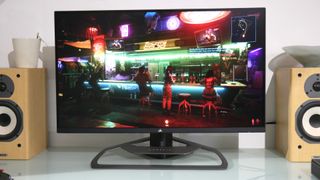
However, it is one of the most accurate gaming panels you can currently buy. Thanks in part to quantum dot technology in the Xeneon’s LED backlight, it’s good for fully 100% of the Adobe RGB gamut and 98% of the even more demanding DCI-P3 color space.
There’s also VESA DisplayHDR 400 certification, plus AMD FreeSync Premium support and Nvidia G-Sync compatibility. Just note this isn’t a true HDR display and lacks features like local dimming.
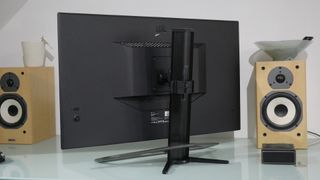
Interface-wise, you get a pair of HDMI 2.0 ports, a single DisplayPort 1.4 socket, plus USB Type-C connectivity complete with device charging for single-cable connectivity to a laptop.
For the record, the HDMI ports only support a maximum refresh of 144Hz. That said, Corsair is pitching the 32QHD165 as a console-friendly panel courtesy of support for 4K input, which is then downscaled to 1440p. Hopefully the PS5 will soon match the Xbox Series X in natively supporting 1440p, as that would be a much better solution.
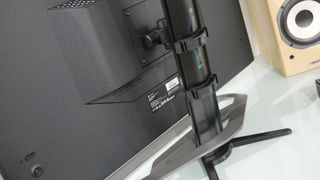
Anyway, this is also a very nicely engineered screen, with a widely adjustable die-cast aluminium stand and one of the cleanest, clearest and most user-friendly OSD menus we’ve ever seen.
But how does the Corsair Xeneon 32QHD165 actually look? Its core image quality is frankly fab. It’s bright, vibrant and punchy, while also being natural looking and nicely calibrated right out of the box.
As for pixel response, Corsair has included three levels of user-configurable overdrive and even in the fastest setting, there’s almost no visible overshoot or inverse ghosting.
Granted, the subjective experience is of a very quick screen, rather than the absolute fastest we’ve ever seen. But overall, there’s minimal blurring. The same goes for latency. There are screens with higher refresh. But you’d have to be a very committed esports addict to take issue with the Corsair Xeneon 32QHD165 running at 165Hz.
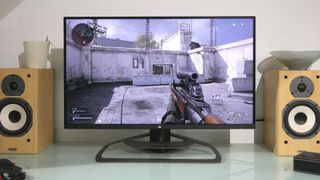
Less impressive is HDR performance, which scarcely looks any punchier than SDR content. That said, it will correctly decode an HDR signal and, with a little tweaking, SDR content looks good in HDR mode. So you have the option of running the Corsair Xeneon 32QHD165 in HDR mode all the time to make your life that little bit simpler.
Whatever, pretty much every kind of game looks great on the Corsair Xeneon 32QHD165. Shooters like Call of Duty and Apex Legends look sharp. Graphical fests like Cyberpunk 2077 and the Forza racing games have plenty of punch. And there’s enough detail to do justice to a strategy title like one of the Total War series.
All of which means the Corsair Xeneon 32QHD165 is a very nicely executed gaming panel with no major flaws, super image quality, plenty of speed and a great feature set.
We just wish it didn’t cost quite so much, as $799 (£699, AU$999) sure is punchy for a 1440p panel. In fact, it’s pretty much 4K money. If that arguably isn’t the point, what certainly is relevant is that you can have similar on-paper specs for around half the money. Ouch.
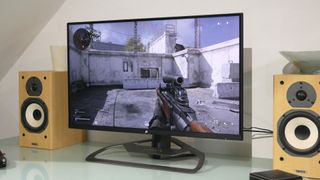
Buy it if...
You agree that 1440p rather than 1080p or 4K is the sweet spot
...for PC gaming and the best compromise between graphical detail and maximising frame rates.
You reckon 165Hz refresh is plenty for pretty much any kind of gaming
Which it surely is, unless you’re a borderline pro-level esports protagonist.
You want some accuracy with your speed
The Corsair Xeneon 32QHD165 sports excellent coverage of both the Adobe sRGB and DCI-P3 gamuts.
Don't buy it if...
You demand the absolute last word in pixel response
The Corsair Xeneon 32QHD165 is fast, to be sure. But there are faster monitors out there.
You also want a high-DPI monitor for desktop work
1440p is great for gaming, but makes for relatively poor pixel density on the desktop thanks to the 32-inch panel.
You want a true HDR experience
The Corsair Xeneon 32QHD165 lacks full-array local dimming and can’t truly render high dynamic range images.
- We pick the best monitors
Technology and cars. Increasingly the twain shall meet. Which is handy, because Jeremy (Twitter) is addicted to both. Long-time tech journalist, former editor of iCar magazine and incumbent car guru for T3 magazine, Jeremy reckons in-car technology is about to go thermonuclear. No, not exploding cars. That would be silly. And dangerous. But rather an explosive period of unprecedented innovation. Enjoy the ride.
